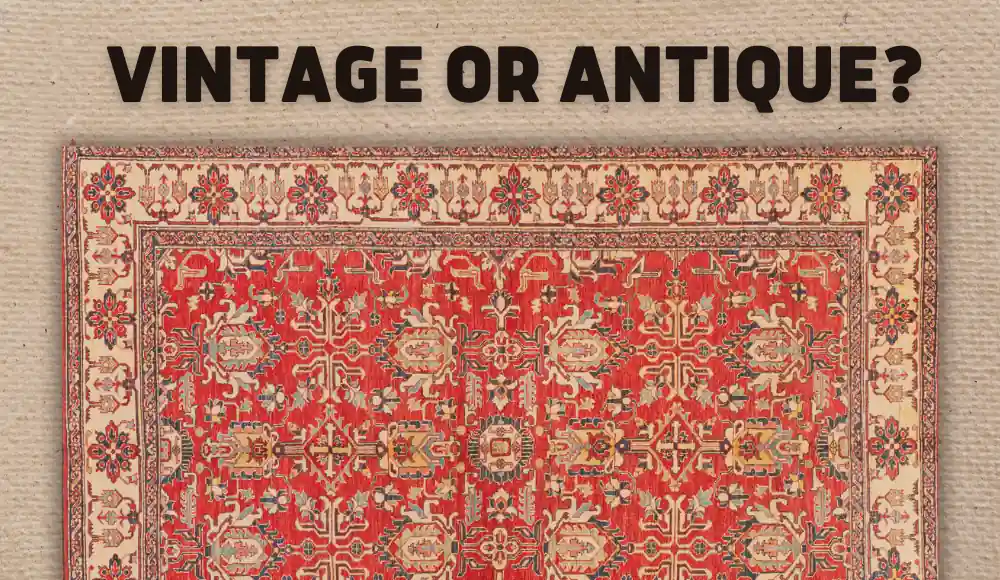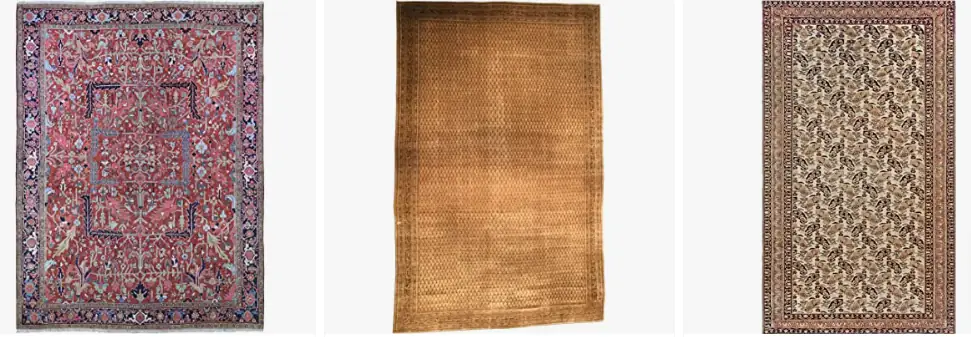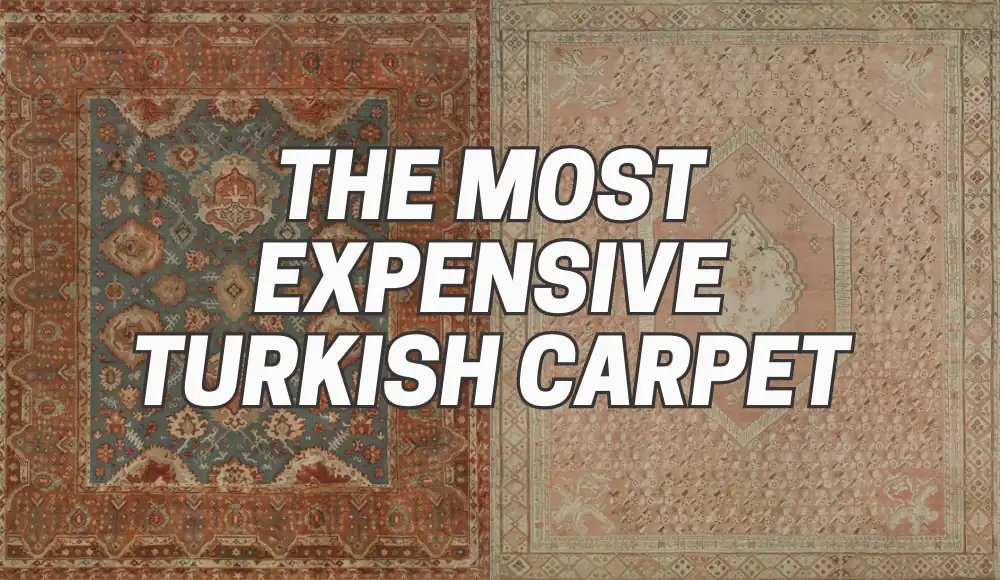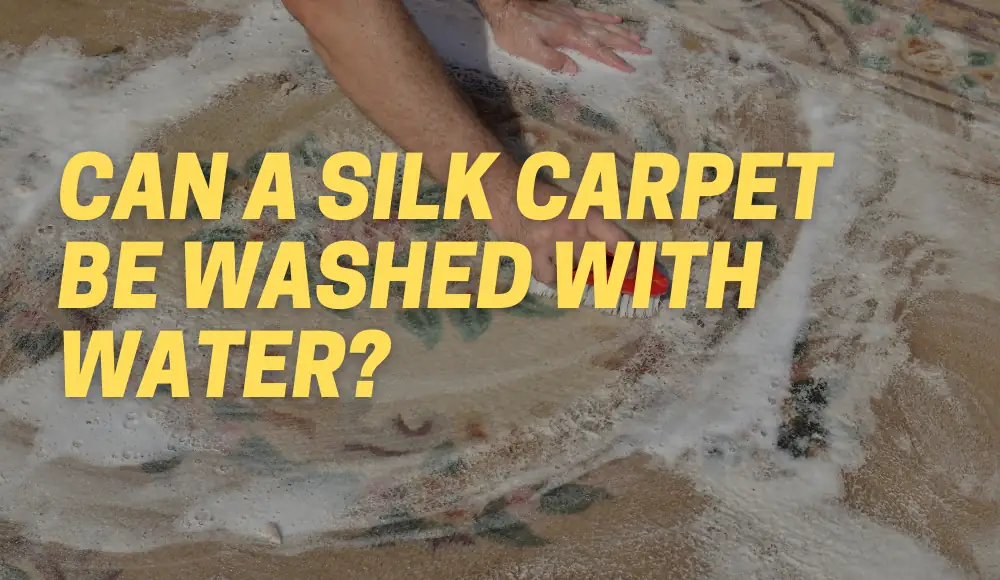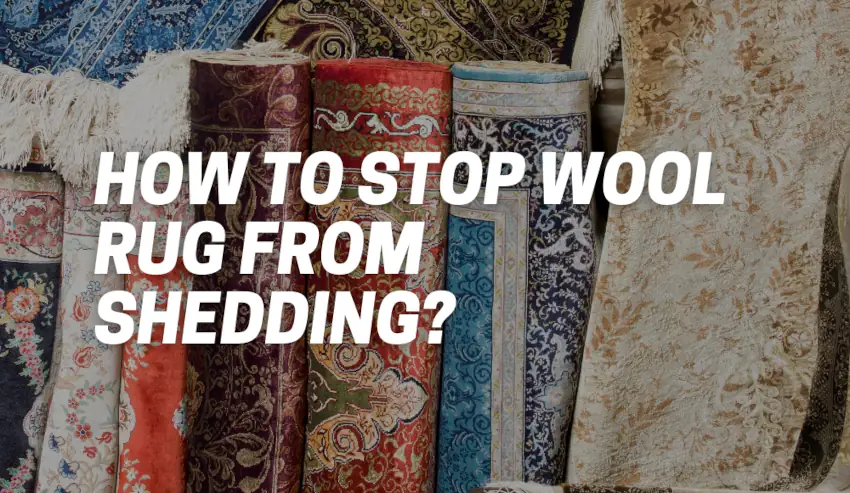Last updated on August 15th, 2023 at 12:47 am
Persian rugs are known all over the world for their intricate designs, vibrant colors, and exceptional quality that makes them stand out from other types of rugs. These beautiful pieces of art have been woven by hand in Iran since ancient times, dating back to as early as 500 BC.
The popularity of Persian rugs has only continued to grow over time and for good reason. Each rug is unique and tells a story through its design and color palette.
They are often passed down from generation to generation and can be considered a valuable family heirloom. However, when it comes to purchasing a Persian rug, it’s important to understand the difference between vintage and antique pieces.
What is Vintage vs Antique?
First things first.
Before diving into the differences between vintage and antique Persian rugs, let’s remind us of the definitions of “vintage” and “antique”.
What means vintage?
Vintage refers to items that are from a previous era and have a certain age, quality, and character that make them valuable and desirable. The term can be applied to a wide range of items, from clothing and accessories to furniture and decor such as carpets and rugs.
Vintage items are typically characterized by high-quality craftsmanship, unique designs, and a sense of history and nostalgia and they continue to be popular with collectors and enthusiasts around the world.
How old is considered vintage?
The age that is considered “vintage” can vary depending on the item or industry.
Generally, items that are at least 20 years old and up to 100 years old are considered vintage. However, some items may be considered vintage if they are over 100 years old, while others may not be considered vintage until they are 50 years old or more. It ultimately depends on the industry, item, and context.
What means antique?
Antique refers to items that are at least 100 years old and have a significant historical or cultural value. Unlike vintage items, which are typically only a few decades old, antique items have been around for a century or more, giving them a unique sense of history and nostalgia.
Antique items are often prized for their craftsmanship, rarity, and cultural significance. They can include a wide range of items, from furniture and artwork to jewelry and decorative objects.
For example, an antique Victorian chair may have intricate woodwork and carvings that were meticulously crafted by hand over a century ago, while an antique Chinese vase may be a rare example of a particular style or period in Chinese art history.
Overall, antique items are valued for their rarity, historical significance, and unique beauty, and they continue to be sought after by collectors and enthusiasts around the world.
The Difference Between Vintage and Antique Persian Rugs
Understanding the difference between vintage and antique Persian rugs is crucial when making a purchase as it can significantly affect the value, rarity, age, and overall aesthetic of the rug.
A vintage Persian rug is typically considered to be between 20-100 years old.
The term “vintage” refers to something that is not quite old enough to be considered antique but still holds value due to its age. Vintage Persian rugs often have more modern designs with bold colors that reflect the style of their time period.

On the other hand, an antique Persian rug is typically over 100 years old with designs that reflect the culture and history of its era. Antique rugs are highly valued due to their rarity; they are often one-of-a-kind pieces that have been preserved for centuries.
Antiques may also have faded colors or muted tones due to age but this can add character and uniqueness rather than detract from their beauty.
Overall, understanding these differences will help you make an informed decision when choosing which type of rug suits your style preferences as well as your budget.
Vintage Persian Rugs
Definition of Vintage Persian Rugs
When it comes to Persian rugs, the term “vintage” refers to a rug that is at least 20 years old but less than 100 years old.
This means that vintage Persian rugs are not as old as antique ones, but they still hold significant historical and cultural value. These rugs were typically made during the mid-20th century and showcase unique designs that reflect the artistry and craftsmanship of their time.
Characteristics That Make a Rug “Vintage”
One of the key characteristics that make a rug “vintage” is its age. As mentioned earlier, vintage Persian rugs are at least 20 years old but less than 100 years old.
Aside from age, these types of rugs also feature distinctive designs and color schemes that were popular during their time. Another characteristic of vintage Persian rugs is their quality.
These rugs weren’t mass-produced like many modern-day carpets, which means each one was crafted with care and attention to detail by skilled artisans. The use of natural fibers like wool or silk also contributes to their durability and longevity.
Popular Styles and Designs of Vintage Persian Rugs
Vintage Persian rugs come in a wide range of styles, designs, and colors.
What is a Hamadan rug? One popular style is the Hamadan rug, which features geometric patterns in rich shades of reds, blues, and browns.
Where do Hamadan rugs come from? Hamadan rugs come from the city of Hamadan, which is located in western Iran. Hamadan is one of the oldest cities in Iran, and it has been an important center for rug weaving for centuries.
Where are Hamadan rugs made? They are typically handwoven using wool or a wool-cotton blend, and they are highly durable, making them a popular choice for use in high-traffic areas. Hamadan rugs are one of the most common types of Persian rugs and are highly sought after by collectors and enthusiasts around the world.

Another popular style is the Shiraz rug, which often includes bold tribal designs in warm earth tones.
Where do Shiraz rugs come from? Shiraz rugs come from the city of Shiraz, which is located in southwestern Iran. Shiraz is known for its rich cultural heritage, including a long history of rug weaving. Shiraz rugs are typically handwoven using high-quality wool.
Shiraz rugs are highly durable and are often used in high-traffic areas such as entryways and living rooms. They are also popular among collectors and enthusiasts for their unique beauty and cultural significance. Some of the most famous Shiraz rugs include the Qashqai and Khamseh designs, which are renowned for their intricate weaving techniques and distinctive designs.
What is the meaning of the Shiraz rug? These rugs have rich cultural and historical significance. The meaning of Shiraz rugs varies depending on the specific design and motifs used in each rug. Many Shiraz rugs incorporate traditional Persian motifs, such as geometric patterns, floral designs, and representations of animals, which are believed to have symbolic meanings.
For example, some Shiraz rugs may feature the “boteh” (which means a shrub or herb) or “paisley” motif, which is a teardrop-shaped design that symbolizes fertility and growth. Others may feature the “herati” pattern, which consists of a diamond shape with a floral or fish-like motif in the center and is believed to represent water and the natural world.
In general, Shiraz rugs are prized for their beauty, durability, and cultural significance, and are often used as decorative items in homes and businesses around the world.
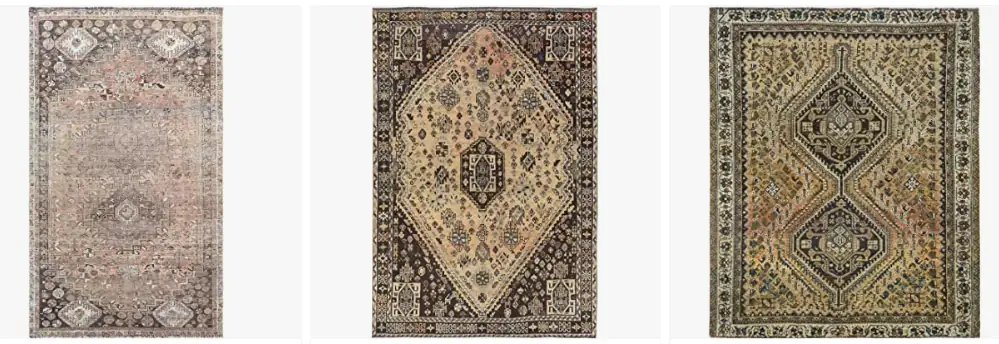
One design element commonly found in vintage Persian rugs is medallions – these are central motifs with intricate details surrounded by ornate borders. Floral designs are also common in vintage Persians – you might find intricate rose or lotus patterns woven throughout the rug.
How to Identify a Vintage Persian Rug
Identifying a vintage Persian rug requires a bit of knowledge and expertise. One way to start is by examining the rug’s fringe – if it’s made of cotton, then there’s a good chance it’s not an antique. You can also look for signs of wear and tear, which are expected in a vintage rug but not in an antique one.
Another factor to consider when identifying a vintage Persian rug is its colors – older rugs often feature more muted tones than newer ones. Examining the knots per square inch can help determine whether the rug is handmade or machine-made – most vintage Persian rugs have around 120 knots per square inch or less, while antique ones can have over 500 knots per square inch.
Antique Persian Rugs
Defining Antique Persian Rugs
What makes a Persian rug antique?
The first question that comes to mind is – How old does a Persian rug have to be to be considered antique? Antique Persian rugs are those that have been in existence for over a century. These rugs are considered to be rare, unique, and valuable due to their age and craftsmanship.
They are made using traditional techniques that have been passed down from generation to generation in Iran. Antique Persian rugs were woven by skilled artisans who used natural dyes and high-quality wool or silk materials, making them highly sought after by collectors and rug enthusiasts alike.
Characteristics of Antique Persian Rugs
Antique Persian rugs have a distinct look that sets them apart from other types of rugs.
They tend to have more muted colors than newer rugs, as the natural dyes used in the past did not produce bright hues like synthetic dyes do today.
The wool or silk fibers used to create antique Persian rugs are also considered superior quality compared to modern mass-produced carpets.
One significant characteristic of antique Persians is their intricate designs, which often feature floral motifs or geometric patterns.

Their size can also vary greatly; some antique Persian rugs can be quite large and cover an entire room while others may be smaller and intended for use as wall hangings or prayer mats.
Historical Significance of Antique Persian Rugs
Antique Persian rugs hold a lot of historical significance due to their connection with Iranian culture and history. These beautiful works of art often tell stories through their designs, depicting scenes from Iranian mythology, history, and daily life.
Additionally, many famous rulers throughout history were known for collecting these precious textiles as they symbolized wealth and luxury.
In modern times, antique Persians continue to play an important role in Iranian culture as they are often passed down through families as heirlooms or gifted at significant life events such as weddings or births.
Identifying an Antique Persian Rug
And how do I know if my Persian rug is antique?
Identifying an antique Persian rug can be a challenging task for those who are not familiar with the intricacies of traditional rug-making techniques. However, there are a few things to look for that can help determine if a rug is truly antique or not.
Firstly, check the weave of the rug. Antique Persian rugs tend to have a more irregular weave due to being handmade on a loom as opposed to machine-made.
Additionally, take note of any wear and tear on the rug’s edges or fringes, as this can be a sign of age. Pay attention to the design and colors used in the rug.
As mentioned before, antique Persians often feature muted colors and intricate designs that may tell stories about Iranian culture or history.
If you’re unsure about the authenticity of an antique Persian rug, it’s always best to consult with an expert in traditional rugs before making any purchases.
More Differences Between Vintage and Antique Persian Rugs
The age difference between the two types
When it comes to vintage and antique Persian rugs, age is one of the main factors that differentiate them. A rug is considered vintage when it’s between 20 to 100 years old, while an antique rug is over 100 years old.
This means that antique rugs are much rarer compared to vintage rugs. The age of a rug affects more than just its rarity, as it also plays a significant role in determining its value.
Antique Persians are typically more valuable than vintage ones due to their increased rarity and the fact that they’ve been around for a longer period of time.
However, both types are still highly desirable for their unique beauty and quality craftsmanship.
Rarity Factor
Rarity is another factor that differentiates vintage and antique Persian rugs.
As previously mentioned, antique rugs are rarer due to their age, which makes them more valuable. However, this doesn’t mean that all antique Persians are extremely rare or valuable – some styles or designs might be much more common than others.
Similarly, not all vintage Persian rugs are common either – some styles or designs might be rarer than others as well. Rarity is one of the main factors that collectors consider when determining the value of a rug.
Value Differences
Aside from age and rarity, there are other factors that affect the value of vintage and antique Persian rugs.
For example, condition plays a significant role in determining how much a rug is worth – an excellent condition piece would be worth much more than one with significant wear and tear.
Other factors include design intricacy and uniqueness, size, quality of materials used (such as silk vs wool), and historical significance (such as if it was made during a particular dynasty).
All these aspects add up to determine how valuable a rug is.
Factors that Affect Value
Some of the main factors that affect the value of Persian rugs include age, rarity, condition, design intricacy and uniqueness, size, quality materials used, and historical significance.
Collectors and enthusiasts alike consider all these factors when determining a rug’s worth.
It’s important to note that the value of a rug can also vary based on market trends – what might be highly sought after at one point in time might not be as popular later on.
Thus, it’s crucial to research the current market trends before purchasing or selling a vintage or antique Persian rug.
Examples of High-Value Vintage/Antique Persians
Some examples of high-value vintage and antique Persian rugs include the Tabriz carpet from Iran (may be worth over $100 000), as well as the Kashan carpet (which features intricate floral designs), and Qum silk rug (known for its exquisite detail work).
Other notable examples include the Heriz carpet (known for its bold colors), Bijar carpet (which has an incredibly dense weave), and Mashad carpet (which often features intricate medallion designs). These rugs showcase just how unique and valuable Persian rugs can be – each one is truly a work of art.
Caring for Vintage and Antique Rugs
Cleaning Tips for Both Types
Cleaning your vintage or antique Persian rug may seem like a daunting task, but it’s important to keep them free of dirt and dust to maintain their beauty and value. The first step is prevention – place your rug in an area that doesn’t get too much foot traffic or direct sunlight. This will help reduce the amount of dirt and fading over time.
- If you do need to clean it, use a vacuum cleaner with a low suction setting or a soft-bristled brush to gently remove any loose debris. For stains or spills, act quickly!
- Blot the area with a clean cloth as soon as possible to prevent the stain from setting in. Avoid using harsh chemicals or detergents on your vintage or antique Persian rug, as they can damage delicate fibers.
- Instead, use mild soap and warm water to gently clean the affected area. If you’re unsure about cleaning the rug yourself, consider hiring a professional cleaner who specializes in antique rugs.
How to Clean Antique Rugs
Maintenance Tips for Preserving Quality
Preserving the quality of your vintage or antique Persian rug requires regular maintenance. One important step is rotating it every few months to ensure even wear and tear.
You should also avoid placing heavy furniture on top of your rug for extended periods of time, as this can cause permanent damage.
Another way to preserve the quality is by protecting it from direct sunlight and moisture. Too much exposure can cause fading and mold growth over time.
To prevent this, try using window coverings or blinds during peak sunlight hours and keeping indoor humidity levels low.
Be mindful of how you store your vintage or antique Persian rug when not in use.
Roll it up with acid-free paper in between layers to prevent creases from forming, which can be difficult to remove once they’ve set in.
By following these cleaning and maintenance tips, you can ensure that your vintage or antique Persian rug remains a beautiful and valuable piece of art for years to come.
Conclusion
Final thoughts on why these rugs are valuable pieces of art
Persian rugs have been around for centuries and continue to be coveted by collectors all over the world. The intricate designs, vibrant colors, and high-quality materials make each rug a one-of-a-kind piece of art that can add beauty to any space.
Beyond their aesthetic appeal, there is also a lot of history woven into each rug. Antique Persian rugs tell stories about the culture and traditions of the people who created them, while vintage Persian rugs reflect the artistic styles popular during their time period.
Owning a vintage or antique Persian rug is not just an investment in a beautiful piece for your home; it’s an investment in artistry and cultural heritage. These pieces can provide an enriching addition to any space while also preserving tradition for future generations to enjoy.
